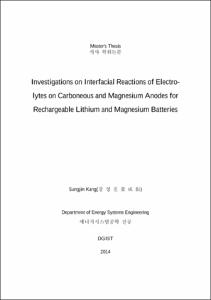Investigations on Interfacial Reactions of Electro-lytes on Carboneous and Magnesium Anodes for Rechargeable Lithium and Magnesium Batteries
- Title
- Investigations on Interfacial Reactions of Electro-lytes on Carboneous and Magnesium Anodes for Rechargeable Lithium and Magnesium Batteries
- Alternative Title
- 리튬 및 마그네슘 이차전지용 카본과 마그네슘 음극에서의 전해액 계면 연구
- Author(s)
- Kang, Sung Jin
- DGIST Authors
- Kang, Sung Jin ; Lee, Ho Chun ; Kim, Jae Hyeon
- Advisor
- Lee, Ho Chun
- Co-Advisor(s)
- Kim, Jae Hyeon
- Issued Date
- 2014
- Awarded Date
- 2014. 2
- Type
- Thesis
- Subject
- Li-ion batteries ; HF ; LiF ; Mg-ion batteries ; Sulfone electrolyte
- Abstract
-
This study investigated the effects of HF, an impurity in LiPF6 electrolytes, on redox reactions of graphite anodes for the lithium-ion batteries (LIBs) and electrolyte solution for magnesium-ion batteries were developed, based on sulfone group solution, non-Grignard reagents.
In the first place, it is found that pyrolytic graphite edge plane electrode (PGE) presents reversible Li+ transport behavior in LiClO4 solution, but suppressed intercalation/de-intercalation reaction in LiPF6 electro-lyte. The sluggish intercalation/de-intercalation reaction in LiPF6 is progressed by adding a HF scavenger, whereas the facile intercalation/de-intercalation reaction in LiClO4 is depressed by adding HF. In addition, the Li+ transport in LiPF6 is enhanced by decreasing electrolyte volume or by increasing PGE surface area. These behaviors are attributed to the HF-induced formation of LiF layer on graphite anode surface, which is facilitated at high ratio of electrolyte volume to electrode area (V/A ratio). The electrolyte-volume-to-electrode-area ratio affects the Li+ transport behavior of the graphite composite electrodes for commercial grade LIBs. This study explains on an age-old question: why Li+ transport behavior of graphite anode in LiPF6 is suppressed in flooded cells, but not in commercial LIBs. Areas of electrode surface were carried out by double-layer capacitances (Cdl) which related to a fraction of edge (fe).
Lastly, it is necessary that new electrolyte of reversible magnesium system is developed instead of Grignard-based because of its unstable chemically and electrochemically. Sulfone-based solutions are one of good can-didates. Dialkyl sulfones (R1R2SO2) such as dipropyl sulfone (DPSO2), ethyl-methyl sulfone (EMSO2) and dibutyl sulfone (DBSO2) were performed with conventional magnesium salt (MgCl2) in CVs. Eutectic of sulfone-based electrolyte and co-solvent with sulfone electrolyte were performed. Especially, cell perfor-mances were enhanced when adding tetrahydrofuran (THF) in dialkyl sulfone electrolyte by volume ration one to one (1/1 = v/v). The high performance sulfone electrolyte such as DPSO2 and DPSO2/THF were com-pared with their characteristics such as ionic conductivity. Ionic conductivity is improved with adding THF in sulfone solution. Besides the study of cathode materials and current collectors, incompatibility between the electrolytes, which may be related to the chemical instability of the Grignard reagent-based electrolyte, is also critical issues for rechargeable Mg battery with a good performance. Therefore, understanding the electro-chemical behavior of current collectors and synthesis of stable electrolyte are critical for Mg batteries.
ⓒ 2014 DGIST
- Table Of Contents
-
Ⅰ. INTRODUCTION 1--
1.1 Li-ion battery: Suppressive effects of electrolyte-volume to electrode-area ratio (V/A ratio) on redox behaviors of graphite anodes 1--
1.2 Mg-ion battery: Sulfone electrolytes for rechargeable magnesium system 3--
Ⅱ. EXPERIMENTAL 7--
2.1 Li-ion battery 7--
2.1.1 Chemicals 7--
2.1.2 Electrochemical measurements 7--
2.2 Mg-ion battery 8--
2.2.1 Chemicals 8--
2.2.2 Electrochemical measurements 8--
Ⅲ. RESULTS AND DISCUSSION 10--
3.1 Li-ion battery 10--
3.1.1 Li salt effects on the Li+ ion transport behavior of PGE: LiPF6 vs. LiClO4 10--
3.1.2 Effects of the V/A area ratio (V/A ratio) 12--
3.1.3 XPS 15--
3.1.4 Area comparison by double-layer capacitances (Cdl) of emery-PGE and alumina-PGE 17--
3.1.5 Proposed mechanism dependence on the V/A ratio 19--
3.1.6 Comparison theoretical capacity with experimental capacity of graphite composite 20--
3.2 Mg-ion battery 23--
3.2.1 Searching for reversible Mg electrolyte 23--
3.2.2 Dialkyl sulfone-based electrolytes 24--
3.2.3 Eutectic: dialkyl sulfones used for co-solvent electrolyte 28--
3.2.4 Dialkyl sulfones with THF (1/1, vol) electrolyte 32--
3.2.5 Comparison efficiencies with volume changing of DPSO2 and THF 34--
3.2.6 Characteristics of DPSO2 vs. DPSO2/THF (1/1) and ionic conductivity 36--
3.2.7 CVs and coin cell test of Chevrel phase cathode electrode with DPSO2/THF solu-tion 37--
3.2.8 Corrosion of current collectors in DPSO2/THF electrolyte 40--
Ⅳ. CONCLUSION 42--
4.1 Li-ion battery 42--
4.2 Mg-ion battery 42
- URI
-
http://dgist.dcollection.net/jsp/common/DcLoOrgPer.jsp?sItemId=000002262534
http://hdl.handle.net/20.500.11750/1342
- Degree
- Master
- Department
- Energy Systems Engineering
- Publisher
- DGIST
- Related Researcher
-
-
Lee, Hochun
- Research Interests Lithium-ion batteries; Novel Materials for rechargeable batteries; Novel energy conversion;storage systems; Electrochemistry; 리튬이차전지; 이차전지용 신규 전극 및 전해액; 신규 에너지변환 및 저장 시스템; 전기화학
-
- Files in This Item:
-
 기타 데이터 / 2.02 MB / Adobe PDF
download
기타 데이터 / 2.02 MB / Adobe PDF
download
- Appears in Collections:
- Department of Energy Science and Engineering Theses Master



